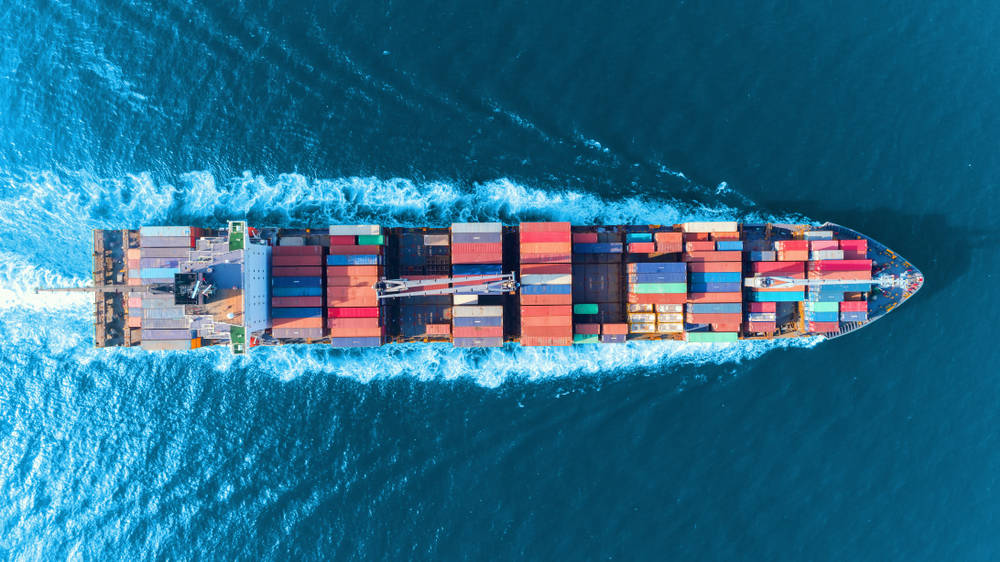We use Cookies. Read our Terms
- News
- What’s In a Container?
What’s In a Container?
Financial institutions are promoting green economies and sustainable trade through green trade finance mechanisms

Photo: Studio concept/Shutterstock.com
Finance, transportation and commodity trading collectively play an essential role in helping countries reduce emissions and tackle climate change. By increasing the availability and affordability of climate-friendly goods, services and technologies through trade finance, banks and multilaterals are collectively driving sustainability in global trade and supply chains.
The World Trade Organization’s (WTO) World Trade Report 2022 argues that trade is a force for good for climate and part of the solution for achieving a low-carbon, resilient and just energy transition. “While trade itself does generate emissions from production and transport, trade and trade policies can accelerate the dissemination of cutting-edge technologies and best practices, and enhance incentives for further innovation,” says WTO Director- General Ngozi Okonjo-Iweala. “Trade is instrumental for investments in clean energy to have the greatest reach and impacts, at lowest cost and where they are needed the most.”
This is where green trade finance comes in. Yunus Energy, a Pakistan-based renewable energy company, was able to obtain blades, generators and turbines for the development of the country’s first wind farm in the village of Jhampir, 100km from the capital Karachi, from Germany with the support of a green trade finance line from the International Finance Corporation (IFC) and Deutsche Bank. IFC issued a guarantee to Deutsche Bank to back a letter of credit issued by the local Bank Al Habib, which allowed Yunus Energy to import the equipment.
“Through our Climate-Smart Trade Finance initiative we use our existing trade finance facilities to support the financing of imports, exports and the local distribution of imported green technologies and materials,” says Nathalie Louat, IFC Director, Trade and Supply Chain at IFC, which has supported transactions with 108 partner banks in 37 countries under this initiative since 2013. “This way we are promoting the sustainability of investments, projects, traded goods and the whole supply chain. Our goal is to support industries and companies to ensure sustainability, cut emissions and adopt energy-efficient technologies.”
Similar to IFC, several leading multilateral development financial institutions as well as commercial banks are increasingly adopting green trade finance programs and initiatives offering specialized terms and incentives to their corporate clients to promote sustainable trade. The Green Trade Facilitation Programme of the European Bank for Reconstruction and Development (EBRD) is an award-winning facility that has supported almost 1,300 foreign trade transactions involving trade in higher performance technologies and sustainably-sourced materials with a total volume of almost €1.5 billion across 26 countries to date. According to the EBRD, these transactions resulted in annual energy savings of over 6,000 GWh, water savings of almost 1.7 million cubic meters and CO2-equivalent emission reductions of more than 3,000 kilotons.
Safeguards for eligibility
The global trade finance gap increased during the COVID-19 pandemic. According to the Asian Development Bank, the gulf between trade finance supply and demand reached US$1.7 trillion in 2020, with rejection rates for small and medium-sized enterprises reaching 40 percent. Now, with soaring inflation, the war in Ukraine and supply chain pressures the difference is even larger.
In order to meet high demand and create an efficient, transparent and interoperable global structure, the trade finance ecosystem is focusing efforts on standardization, according to a McKinsey report. The paper warns that differences between the development and application of standards pose multi-level challenges from trade documentation to product definition, specifically the definition of sustainable trade products.
In order to ensure that their trade is actually “green”, traders and banks need to cooperate closely and ensure that certain criteria are met. IFC, for example, has a clearly defined list for eligible green trade products. The institution is also asking for international accreditations and certifications such as Fair Trade, Better Cotton Initiative or Rainforest Alliance to promote the sustainability of agro-trade. “We have a responsibility to safeguard these standards and ensure that climate-smart trade finance products are offered to corporates and partner banks which operate with similar criteria and values,” says IFC’s Nathalie Louat. “This way we can have a material and meaningful impact on climate change through trade finance.”
The Pilot Sustainability Performance Framework
At the UN climate change conference COP27 in November, the International Chamber of Commerce (ICC) launched a pilot of the first-ever industry framework to assess the sustainability performance of trade transactions. Trade banks, corporations, technology players and a consultancy worked together to create the Wave 1 framework, which is intended to move the industry toward standardized international reporting and assessment of sustainable supply chains.
At the summit, ICC Secretary General John W.H. Denton AO announced that more than 20 banks and corporates have pledged to pilot the application of the Wave 1 framework for transactions in the textile sector. These include BNP Paribas, Commerzbank, Lloyds Bank, Commonwealth Bank of Australia, DNB, Santander Bank, Société Générale, Wells Fargo and India’s Yes Bank. More banks already announced their intention to join the scheme.
The ICC will publish the findings from these pilots and set out how it will use the results to enhance the framework by mid-2023.